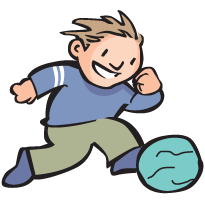Boston Children's Museum
308 Congress Street, Boston, MA 02210
617-426-6500
© Boston Children’s Museum 2025
Website Design by JackrabbitKids in African countries like South Africa play soccer with the same kinds of soccer balls that children all around the world do. But sometimes leather soccer balls are hard to come by, so some children have to improvise and make their own out of whatever they can find. This activity highlights how inventive and industrious children can be when they may not have all the resources they need.
Gather materials—hand a letter out to parents asking for plastic bags, newspapers, packing peanuts, etc. from home…many families have an abundance of these materials. Be creative—the list above is a suggestion, but there are lots of materials that you can use. Be sure to read the Suggestions section (under “Make it Better”) for tips and ideas.

Miscellaneous “recycled” materials, such as:
Ask your students if any of them play soccer. What do you need to play? What might they do if they wanted to play soccer, but didn’t have a ball? Do they think they could make one that was good enough to play with? Ask your students to make a list of the important characteristics of a soccer ball. Have a planning session with them in which you ask them to brainstorm what they might use to create a soccer ball, then have them gather those materials.
Using recycled materials, create a soccer ball that you can play with!
After 10–15 minutes, bring your students together away from the materials to talk about what they have discovered. Was it easy or hard to begin making their soccer balls? What have they discovered about the different materials? Does a soccer ball work well if it is really light? How about if it is really heavy? Is it important for a ball to be round? How might they make it as round as they can? Ask if any teams have a design that they can share with the group, and ask them to talk about their materials and how they are creating their soccer ball.
Have your students return to their construction. They may continue working with their original designs, or start making a new ball. When everyone is finished, gather the teams together to share their finished products. Then, head outside or to a gym to kick the balls around together…and maybe even start a soccer match!